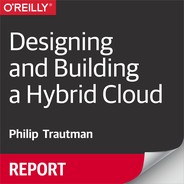Book Description
Enterprises are embracing the hybrid cloud to modernize IT for the digital era, but given the significant complexity that still exists in cross-cloud management and integration, many companies struggle to create an effective hybrid cloud strategy.
In this ebook, IT industry expert Philip Trautman examines why the hybrid cloud has become the preferred enterprise model. IT leaders will learn how to assess, plan, and implement a hybrid cloud strategy to achieve greater visibility and control over both traditional enterprise applications and cloud-native applications—all while decreasing management complexity.
By following this approach, you’ll choose a single framework—a cloud OS—to manage workloads on-premises and in the cloud; modernize on-premises environments; and select cloud providers compatible with the chosen framework.
- Explore hybrid cloud benefits, including the flexibility to take advantage of distributed and edge environments
- Assess your current operations and future workload needs and create a decision matrix to establish hybrid cloud goals
- Choose a cloud operating environment and determine how to modernize data centers and other infrastructure
- Select public clouds, cloud service providers, and SaaS providers that work with your cloud OS
- Shift your development efforts to DevOps to accelerate delivery of new applications and services
- Make organizational changes to ensure hybrid cloud and DevOps success
